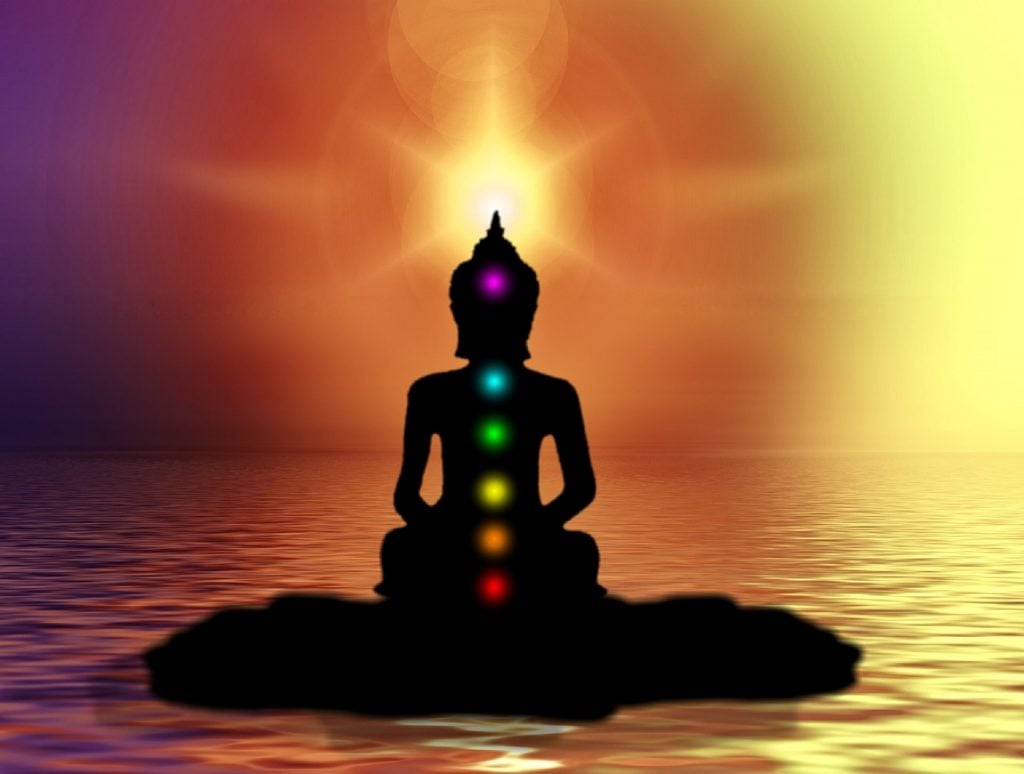What Are Chakras?
Chakras are a number of energy centers in the body running from the bottom to the top of the spinal column. These focal points are a concept originating in the in the earliest forms of Buddhism, Hunduism, and Janism[1] and used during meditation and prayer. Traditionally, each Chakra is believed to have a color, meaning, and its own type of energy. There are anywhere from 5 to 7 Chakras depending on the tradition and discipline one follows. The Chakra colors and their meanings are the basis for color psychology – where each color carries personality and emotional attributes.
Below is the short list of the 7 Chakras along with their Sanskrit names and their associated color:
- Root Chakra | Muladhara Chakra (Red)
- Sacral Chakra | Svadhishthana Chakra (Orange)
- Solar Plexus Chakra | Manipura Chakra (Yellow)
- Heart Chakra | Anahatra Chakra (Green)
- Throat Chakra | Vishuddhi Chakra (Blue)
- Third Eye Chakra | Ajna Chakra (Indigo)
- Crown Chakra | Sahasrara Chakra (Violet)
My name is Alex. I’m from Israel and have been practicing yoga and Chakra meditation ever since I visited India about 9 years ago. In this article, I will teach you the locations of each of the 7 Chakras, their color, and suggested meanings. I will then explore each Chakra & their colors in detail in future articles in this series.

Chakra Colors
The Chakra colors should be quite familiar to most of you. They’re the same colors of the rainbow – red, orange, yellow, green, blue, indigo, and violet.
Not all practitioners agree on the meaning of each Chakra and its color because the concept is quite abstract. Consequently, there are many different interpretations. Regardless, the colors are important because each color has a different frequency or vibration. These energies are what make each Chakra different and perform different functions in the mind-body-spirit connection.
Practitioners all agree, however, that the Chakras must be ‘opened’ in order to gain the higher level benefits of their associated energies. Exercises for opening the Chakras vary depending on the Chakra one is trying to open.
It’s interesting to note that even the western world tends to assign emotions to colors. Many of these references directly correspond to the ancient science of Chakra colors. For example, ancient Indian religions associate the Muladhara Chakra, which is red, with emotions such as love and passion. It’s no coincidence that western cultures associate the color red with these very same emotions.
Chakra Locations
As the Chakras are responsible for the various types of energy flowing through the body, they are connected to the nervous system. The Chakras exist at intervals from the base of the spinal cord up through the top of the head.

The basic locations of the Chakras is laid out in the above image. As you can see, they’re essentially a straight line up the spine starting from the bottom (Root) all the way up to the top of the head.
Each Individual Chakra & Their Colors
Each Chakra carries a different level of energy. Below is a brief discussion on each of the Chakras beginning with at the bottom of the spine. I’ll elaborate on each Chakra in future articles in this series.
Muladhara Chakra: The Root Chakra | Red
The Root Chakra is the first Chakra and it’s located at the base of the spine. It’s the energy of strong emotions such as love, passion, and even anger.

Because of it’s position, the Root Chakra is the key to all other Chakras. It is the foundation for which many other energies can flow.
Like the root of a tree, the Muladhara Chakra is our connection to the earth and helps to draw energy from it. Consequently, it’s often associated with the element of the earth.
Read more about the Red Chakra here.
Svadhishthana Chakra: The Sacral Chakra | Orange
The Sacral Chakra is the second Chakra. It sits right at the public bone and is the center of sexual energy, creativity, and desire. In some traditions, the location may also be closer to the genitals.

The Sacral Chakra plays a key role in pleasure and fantasy. Opening this Chakra results in healthier relationships and the ability to relate to the feelings and emotions of others.
The Sacral Chakra is based on the water element and its ability to freely flow. As such, this Chakra is considered a key energy to maintaining flexibility in life and relationships.
Read more about the Orange Chakra here.
Manipura Chakra: The Solar Plexus Chakra | Yellow
The third Chakra, known as the Solar Plexus Chakra, rests just at the upper portion of the stomach. It’s yellow in color, but some practitioners claim it can be golden at higher frequencies[2].

The Solar Plexus Chakra is based on the fire element. This energy is responsible for self discipline and independence.
Also known as The Navel Chakra, the Manipura Chakra is also the energy of intelligence and the feelings of self-belonging.
Read more about the Yellow Chakra here.
Anahata Chakra: The Heart Chakra | Green
The fourth Chakra, known as the Heart Chakra, lies exactly where you’d expect it: at the center of the chest. This Chakra is green and comes from the air element.

The Heart Chakra is one of the most important Chakras and it’s green color is one of the most important colors.
This Chakra overlaps the first and second Chakras because of its importance in love and relationships. Its green color also indicates that it’s connected to nature.
Vishuddhi Chakra: The Throat Chakra | Blue
The fifth Chakra, known as the Throat Chakra, is located at the throat. This Chakra is critical in a person’s ability to communicate effectively.

In addition to communication and voice, the Vishuddhi Chakra is also helpful in other forms of self expression.
One of the most important functions of the Throat Chakra is to act as a conduit for energy from the lower Chakras to the higher ones. Consequently, this Chakra is critical in maintaining the balance between all other Chakras.
Ajna Chakra: The Third Eye Chakra | Indigo
The sixth Chakra, the Third Eye Chakra, is perhaps the most popular of the Chakras because it’s well-known even outside typical tradition. It’s commonly referred to in western culture as simply, “The Third Eye”.

Located on the forehead, the sixth Chakra is responsible for our perception. While many western cultures mistakenly categorize the Third Eye Chakra as some mystical way to see into the future, the reality is a bit more mundane. This Chakra is our “mind’s eye”.
Anytime you visualize something in your head, you’re using the Ajna Chakra. Imagination and the sprouting of new ideas come from this Chakra.
For those who believe in telepathic abilities, it comes with the activation of this Chakra.
Sahasrara Chakra: The Crown Chakra | Violet
The seventh Chakra, the Crown Chakra, can be found at the top of the head. As the highest common Chakra, its full realization eludes many humans for the entirety of their lives.

The Crown Chakra is primarily responsible for our spirituality. It allows our connection to higher beings not of this earth.
Our sense of right and wrong and overall understanding of ethics come from this Chakra. The Crown Chakra exists in all beings which helps to explain why even those who do not follow a specific religion still develop morals and ethics similar to those who do.
Variations in the Chakra Colors
The Chakras colors explained above can vary somewhat. Many practitioners believe that individuals who’ve focused on specific Chakras might change the color because the Chakra has reached a higher level not normally seen.

Opening the Chakras
In general, the first step to opening the Chakras involves meditation. You may find some of your Chakras are already open. In the coming articles in this series, I will go over the details of each of the Chakras, including how to determine if the Chakra is blocked and techniques for opening the Chakra and regaining balance.
Until then, I hope you enjoyed this read and learned more about the Chakras.
References & Additional Reading
1. Wikipedia: Chakra
2. Chakras.info: The Solar Plexus Chakra
3. Color Psychology: Chakra Colors: Ultimate Guide to 7 Chakras and their Meanings
I'm a freelance writer from Israel. I like to write about just about anything. English is my 2nd language so please forgive me if my writing isn't perfect.



I’ve always felt that the Chakras exist only in our minds… that’s not to say they are completely made up. But there seems to be definitely some logical separation between the groups of traits assigned to each Chakra that ‘focusing’ on each of those groups would help someone to look inward for balancing their mental and emotional state.